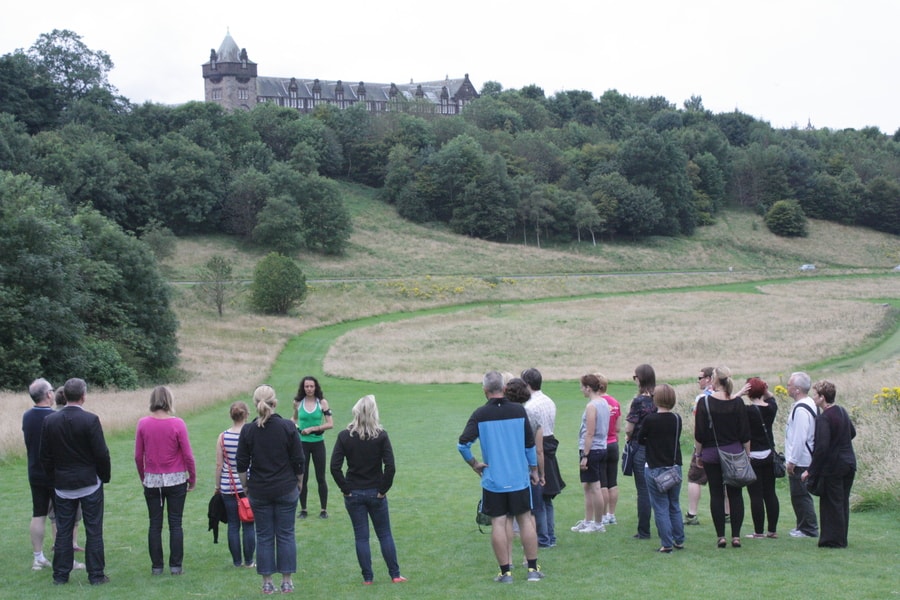In 2021, outdoor theatre is an old idea with a new problem. As audiences emerge, blinking, from our pandemic caves, how do artists help us navigate what it means to share space again? View the great outdoors as a safety necessity rather than an artistic opportunity, and you risk a paint-by-numbers production, a proscenium-based design cut-and-pasted wholesale. Instead, as we all get used to being together again, why not help reacquaint us with what it means to be part of public life in public space?
“As an artist, it transports you to another plane of existence to accept the natural world as your collaborator,” said Suchan Vodoor (he/him), director of Endure, A Run Woman Show, which runs July 3–August 8 in New York City’s Central Park. “Working in public space, you feel connected to your fellow humans in a very immediate way.”
Melanie Jones (she/her) first created this solo piece, which has audience members don numbers and (literally) follow a marathon runner through a blend of audio and dance theatre that tells the personal story of a woman’s journey to her first marathon, more than 10 years ago. “Every time I circle back to Endure, magical things happen,” she said.
Together with Vodoor, who has been with the project since 2011, Jones has staged Endure in New York and Edinburgh, in London during the 2012 Olympic Games, and in Jones’s hometown of Calgary, where the last full performance run of Endure took place in 2013. By now they know well what they can and can’t control, and how to maximize the unpredictability of public space.
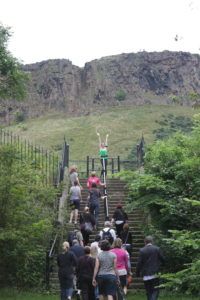
Things you can control: your route and your timing. Vodoor scouts Endure locations with an acute awareness of where the sun will be at any given moment, and of how the community tends to use a location at different times of day. Because all Endure audio is prerecorded, some scenes are built to happen as the group moves longer distances, while others happen back-to-back-to-back, requiring a cluster of adjacent locations. Certain patterns of audience behavior are likewise reliable: People gravitate toward good sight lines and, in hot weather, to shade.
But there’s so much you can’t control, which imparts in Endure an aliveness that simply can’t exist in more structured theatrical environments, short of putting a baby or a poorly trained animal onstage.
“We gave up so many things that seemed almost unthinkable to give up,” Vodoor said when thinking about the control over theatrical elements that has been given up. “I think in exchange, we got the ability to be surprised and delighted alongside our audiences with every single step of the artistic process.”
Joggers out for their regular run inadvertently become a sort of marathoner’s Greek chorus, or perhaps rugby players make room to share their space as the group jogs past. A moment involving fake blood has brought many a concerned bystander running to help in years past.
“We rely on the fact that synchronicity and magic will meet us wherever we go,” Jones said. “It’s a pretty trustworthy part of the show.”
(It’s worth noting that no one in the audience is required to run—you can walk and not miss anything. “Our show is as much for theatre people as it is for runners, and we create theatre audiences out of runners. This is the wild wilderness of audience development!” Jones joked.)
During this summer’s Central Park run, Jones and Vodoor will also be workshopping a new show under the Run Woman Show umbrella. In Mother, Jones will apply the framework of the marathon to the endurance event that is motherhood. Running is still present, but in many ways it’s a journey of longing because the mother doesn’t get to run anymore, for any number of reasons.
“Endure has a simple journey: You start at the starting line, and you finish at the finish,” Jones said. “Motherhood and Mother are inherently messier, inherently less cute, less pat, less tie-up-in-a-bow-able, right? All I can speak about is my own experience, where at the beginning of motherhood, I wanted to get it over with as quickly as possible. It was so shocking, so hard, so relentless.” When her child turned 4, she continued, “it was deep in the lockdown summer, and I got to the point where I realized, ‘Oh, mother is a verb, and mother is how we will actually endure all this.”
Inspired by the sea of humanity present at every marathon starting line, Jones and Vodoor hope to expand the umbrella even further in the future, into a seasonal repertory company that produces existing shows every summer and creates new shows to add to the play cycle, all connected by a loose thread of distance running. “The beautiful thing of a marathon is you walk up to the start line, and there are 50,000 individual people, fully formed,” Jones said. The characters are infinite, as are the stories they could tell.
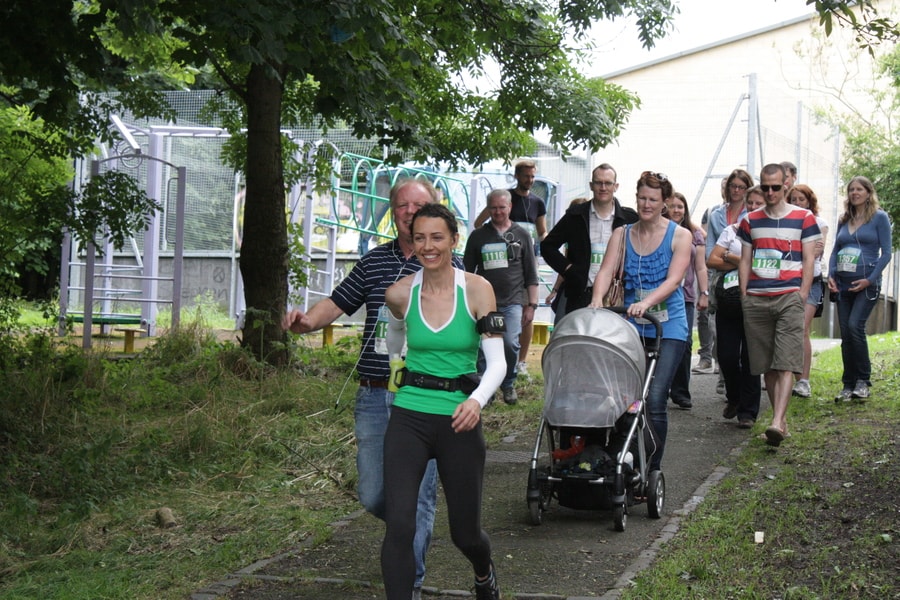
Space may be a fixed resource, by some measures, but it’s also entirely what we make of it. “I sometimes think about [cabaret] as reverse immersive theatre, where the audience creates the space that the performer then enters and immerses themselves in,” said John Jarboe (she/her), artistic director of the Bearded Ladies Cabaret Company in Philadelphia. “Cabaret is about getting you to see yourself, and see yourself seeing each other, so it’s more about the audience than it is about what’s onstage.”
Enter the stage: the Beardmobile, a 15-foot box truck-turned-performance space, dreamed up as a COVID-era adaptation of Late Night Snacks, the Beards’ annual cabaret festival, designed in collaboration with a neighborhood. Outfitted with neon LED lighting, high-powered speakers, a six-foot retractable stage, and room for a three-piece band, not to mention some pretty pink COVID safety signage, the Beardmobile can easily take the Beards’ brand of high-energy queer performance on the road, and has been doing its Bearded Love Tour throughout Philadelphia during the month of May.
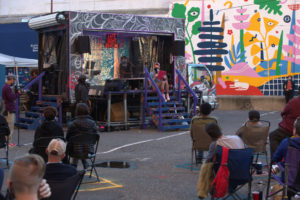
Explained Jarboe, the company wants to put communities in control, prioritizing art that is meaningful to them. “A neighborhood is not a venue,” said Jarboe, though she quickly credited Beards artist Sam Rise with the turn of phrase. “So what is a neighborhood? It’s a curator. And they are hosting us, not the other way around, which feels really rich and necessary for the kind of exchange that’s happening.”
Exchange is a two-way street. That’s why the truck is, as Jarboe described it, so very gay and outlandish: to create a space that brings joy, that is both inviting and totally uncompromising about queerness.
Honoring the neighborhood-as-curator concept feels rich and necessary for modern mobile theatre in general, much of which could use a thoughtful update. “Why are we driving around doing Shakespeare for people? Who asked for that?” said Jarboe with a laugh.
Accordingly, the Beards ask themselves questions before shifting their truck into gear: Are they going to a place where they’re welcomed by people who want to have them? Are people prepared for them to be there? Should the Beards be performing, or should they share the stage with other artists or organizations?
The Beards love sleeping around, collaboratively speaking, and the roster of partner artists and organizations who participated in the Beardmobile’s debut run of outdoor pop-up performances included Project Home; Opera Philly’s all-city youth choir, T-VOCE; and former Philadelphia Poet Laureate Yolanda Wisher and Philadelphia Contemporary. There was a drag Mother’s Day event celebrating queer family, and an open mic showcasing talents from the Gloria Casarez Residence, a queer-friendly home for young people.
“What’s so great about this partnership model is that we’re working with artists and artist-led organizations whose values we share,” Jarboe said. Those partners, in turn, work with the Beards to pair with the perfect host from a roster of Beards artists including Brett Robinson, Eric Jaffe, Anthony Martinez-Briggs, Sam Rise, Cookie Diorio, Jess Conda, and Jarboe.
The debut Beardmobile run wraps up on May 29, but that’s just the beginning for this glittery heaven-on-wheels, Jarboe said. The Beards are planning to release a documentary created from professional footage of these first performances. “We’re trying to fight the FOMO,” Jarboe said, and, speaking as a West Coaster, I say thank you. Another performance series is planned for the fall: stay tuned.
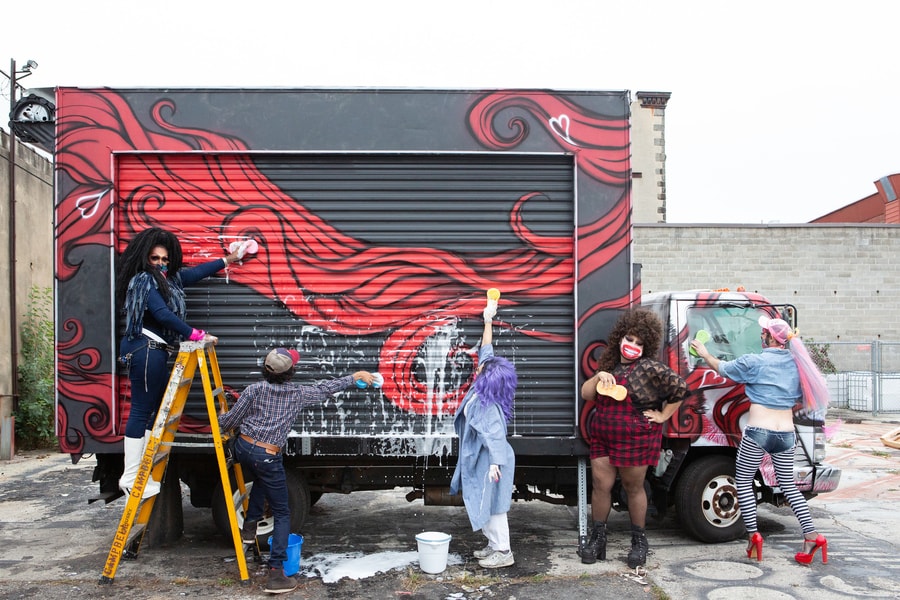
Like many of us, Ryan Guzzo Purcell (he/him) found himself revisiting spaces he thought he knew throughout this past year, wandering through the neighborhoods in South Seattle near where he grew up and lives again today.
“When you direct a play, you talk about, how does a character reveal themselves? What does the audience need to see and experience and understand to connect to this character?” Purcell said, zipping his coat against the Seattle drizzle when I met up with him for an interview. “Places also have character, so for this project it’s the same question: How does the character of this area reveal itself?”
As he walked, Purcell, artistic director of Seattle theatre company the Williams Project, chewed on ideas of mindfulness, art, and money, on the wild wealth inequality visible in such a small neighborhood, and on the limits of human cognition that keep us from understanding concepts like money and time on a massive, meaningful scale.
The result of his musings will take shape June 5–20, as Purcell leads small audiences through the Mount Baker neighborhood, a two-mile route beginning and ending under a spreading silver birch tree in front of Franklin High School, a stately 1912 school building and Purcell’s alma mater (and mine).
The Wealth Walk, as this theatrical project is called, is an unusual combination of mindfulness and entertainment, amalgamating theatre, durational performance art, guided meditation, historical walking tour, and thought experiment, enlivened by theatrical excerpts and small, shared intimacies between audience members. Beginning June 4, The Wealth Walk will also be available as an audio guide to allow people to enjoy the walk in their own time.
Purcell’s path leads you through a verdant neighborhood originally designed as a planned community bound by a racially restrictive covenant in 1907, built high on a ridge overlooking Lake Washington. A short walk downhill from these multi-million homes takes you to Rainier Avenue, the thoroughfare that cuts through the heart of the Rainier Valley, home to wave after wave of immigrants to Seattle over the decades.
Folksy narration sets the scene. “We’re not doing the good version of Our Town—we’re doing the version that lives in people’s imaginations,” Purcell joked of his direction to Williams Project member Charlie Thurston, whose voice is heard in sections inspired by Thornton Wilder and Lorraine Hansberry. Capturing that aggressively old-timey language is warm and fun, Purcell said, but it also reflects the hazy nostalgia that is constantly whitewashing in our culture.
Stops along the way acknowledge both notable landmarks and audience distance traveled as a physical stand-in for the accumulation of wealth. Elements of the show are as tricky and unsatisfying to explain in writing as the concepts they’re working to elucidate—like the passage of 4,000 years, or the difference between $10 billion and $100 billion. Without the proper context, your brain just can’t hang on to those concepts.
The walk asks a lot of its audience members: attention, patience, a willingness to be consciously in your own body and in your surroundings. Once I got over my fear of being reported on NextDoor, the results were cumulative. Long periods of quiet observation can feel awkward, but the effects build up in your system to remind you that your active presence here is necessary. Without it, this performance doesn’t exist. The same is true of this community, this place that I live.
Wealth is a salient topic in the best of times but particularly in a pandemic year, particularly in a region that’s home to both Jeff Bezos and Bill Gates, and particularly for a theatre company that has, from the moment of inception, built its business model on paying artists a living wage.
“One’s attitude towards wealth is not always equal to one’s wealth,” Purcell explained. He’s not trying to solve wealth inequality here, nor would a piece of shame-based propaganda make interesting theatre. But asking people to really look at the world around them can make a difference, as can the micro-to-macro application of local history.
It matters to know, for instance, that the community center where you’ve attended weddings, dance classes, and community fairs also hosted meetings of a Japanese Investigation Committee. “If I can see how these things apply to this one place, this one neighborhood, which I can understand,” Purcell said, “then I can start to understand how it applies nationally or globally.”
Whether starting with baby steps or a full-blown marathon, the time is ripe for artists with something to say about how we exist in our physical world, who will meet us where we are and welcome us back into the cities we’ve been missing.
“I want to break down this barrier between art and immersive experiences and life, but in a surgical way, not a generic way,” said Endure director Vodoor. “I don’t want people to finish watching a show and say, ‘That was a cool thing that I attended.’ I want them to say, ‘Oh my God, I have such a magical life.’ Because that’s what great art has done for me: become part of me in a way that actually makes me see magic in my life. That’s what I want our show to do. And that’s what I think outdoor theatre in particular can be really well poised to do.”
Gemma Wilson (she/her) is a contributing editor to American Theatre.

